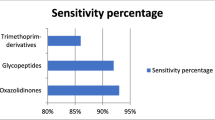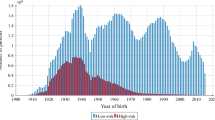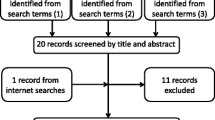Abstract
This study provides a detailed exposition of in-hospital community-acquired methicillin-resistant S. aureus (CA-MRSA) which is a new strain of MRSA, and hospital-acquired methicillin-resistant S. aureus (HA-MRSA) employing Caputo fractional operator. These two strains of MRSA, referred to as staph, have been a serious problem in hospitals and it is known that they give rise to more deaths per year than AIDS. Hence, the transmission dynamics determining whether the CA-MRSA overtakes HA-MRSA is analyzed by means of a non-local fractional derivative. We show the existence and uniqueness of the solutions of the fractional staph infection model through fixed-point theorems. Moreover, stability analysis and iterative solutions are furnished by the recursive procedure. We make use of the parameter values obtained from the Beth Israel Deaconess Medical Center. Analysis of the model under investigation shows that the disease-free equilibrium existing for all parameters is globally asymptotically stable when both \({\mathscr {R}}_0^H\) and \({\mathscr {R}}_0^C\) are less than one. We also carry out the sensitivity analysis to identify the most sensitive parameters for controlling the spread of the infection. Additionally, the solution for the above-mentioned model is obtained by the Laplace-Adomian decomposition method and various simulations are performed by using convenient fractional-order \(\alpha \).













Similar content being viewed by others
Explore related subjects
Discover the latest articles and news from researchers in related subjects, suggested using machine learning.References
Brauer, F.: Compartmental models in epidemiology. In: Mathematical Epidemiology (pp. 19–79). Springer, Berlin (2008)
Byrne, J.P. (ed.): Encyclopedia of Pestilence, Pandemics, and Plagues. Greenwood Press, West Port (2008)
Djuretic, T., Herbert, J., Drobniewski, F., Yates, M., Smith, E.G., Magee, J.G., Crowe, M.: Antibiotic resistant tuberculosis in the United Kingdom: 1993–1999. Thorax 57(6), 477–482 (2002)
Gruson, D., Hilbert, G., Vargas, F., Valentino, R., Bebear, C., Allery, A., Cardinaud, J.P.: Rotation and restricted use of antibiotics in a medical intensive care unit: impact on the incidence of ventilator-associated pneumonia caused by antibiotic-resistant gram-negative bacteria. Am. J. Respirat. Crit. Care Med. 162(3), 837–843 (2000)
Hethcote, H.W.: The mathematics of infectious diseases. SIAM Rev. 42(4), 599–653 (2000)
Joint United Nations Programme on HIV/AIDS. (2010). Global report: UNAIDS report on the global AIDS epidemic 2010. Unaids
Bernoulli, D., Blower, S.: An attempt at a new analysis of the mortality caused by smallpox and of the advantages of inoculation to prevent it. Rev. Med. Virol. 14(5), 275 (2004)
Hamer, W.H.: Epidemic Disease in England: The Evidence of Variability and of Persistency of Type. Bedford Press, Bedford (1906)
Nagle, R.K., Saff, E.B., Snider, A.D.: Fundamentals of differential equations. Pearson Education (2014)
Qureshi, S., Yusuf, A.: Modeling chickenpox disease with fractional derivatives:fFrom caputo to atangana-baleanu. Chaos Solitons Fract. 122, 111–118 (2019)
Qureshi, S., Yusuf, A.: Mathematical modeling for the impacts of deforestation on wildlife species using Caputo differential operator. Chaos Solitons Fract. 126, 32–40 (2019)
Caputo, M., Fabrizio, M.: A new definition of fractional derivative without singular kernel. Progr. Fract. Differ. Appl 1(2), 1–13 (2015)
Atangana, A., Baleanu, D.: New fractional derivatives with nonlocal and non-singular kernel: theory and application to heat transfer model. arXiv preprint arXiv:1602.03408 (2016)
Baleanu, D., Fernandez, A.: On fractional operators and their classifications. Mathematics 7(9), 830 (2019)
Yavuz, M.: Novel solution methods for initial boundary value problems of fractional order with conformable differentiation. Int. J. Optim. Control: Theories Appl. (IJOCTA) 8(1), 1–7 (2017)
Baleanu, D., Fernandez, A., Akgül, A.: On a fractional operator combining proportional and classical differintegrals. Mathematics 8(3), 360 (2020)
Qureshi, S., Yusuf, A., Shaikh, A.A., Inc, M., Baleanu, D.: Fractional modeling of blood ethanol concentration system with real data application. Chaos: Interdiscip. J. Nonlinear Sci. 29(1), 013143 (2019)
Yusuf, A., Inc, M., Aliyu, A.I.: On dark optical solitons of the space time nonlinear Schrödinger equation with fractional complex transform for Kerr and power law nonlinearities. J. Coupl. Syst. Multisc. Dyn. 6(2), 114–120 (2018)
Acay, B., Bas, E., Abdeljawad, T.: Fractional economic models based on market equilibrium in the frame of different type kernels. Chaos Solitons Fract. 130, 109438 (2020)
Acay, B., Bas, E., Abdeljawad, T.: Non-local fractional calculus from different viewpoint generated by truncated M-derivative. J. Comput. Appl. Math. 366, 112410 (2020)
Bas, E., Acay, B., Ozarslan, R.: The price adjustment equation with different types of conformable derivatives in market equilibrium (2019)
Acay, B., Ozarslan, R., Bas, E.: Fractional physical models based on falling body problem. AIMS Math. 5(3), 2608 (2020)
D’Agata, E.M., Webb, G.F., Pressley, J.: Rapid emergence of co-colonization with community-acquired and hospital-acquired methicillin-resistant Staphylococcus aureus strains in the hospital setting. Math. Model. Nat. Phenomena 5(3), 76–93 (2010)
Kilbas, A.A.A., Srivastava, H.M., Trujillo, J.J.: Theory and Applications of Fractional Differential Equations (Vol. 204). Elsevier, Amsterdam (2006)
Pressley, J., D’Agata, E.M., Webb, G.F.: The effect of co-colonization with community-acquired and hospital-acquired methicillin-resistant Staphylococcus aureus strains on competitive exclusion. J. Theor. Biol. 264(3), 645–656 (2010)
Wang, Z., Yang, D., Ma, T., Sun, N.: Stability analysis for nonlinear fractional-order systems based on comparison principle. Nonlinear Dyn. 75(1–2), 387–402 (2014)
Naghipour, A., Manafian, J.: Application of the Laplace Adomian decomposition and implicit methods for solving Burgers’ equation. TWMS J. Pure Appl. Math. 6(1), 68–77 (2015)
Shah, K., Bushnaq, S.: Numerical treatment of fractional endemic disease model via Laplace Adomian decomposition method. J. Sci. Arts 17(2), 257 (2017)
Akinlar, M.A., Tchier, F., Inc, M.: Chaos control and solutions of fractional-order Malkus waterwheel model. Chaos Solitons Fract. 135, 109746 (2020)
Qureshi, S., Yusuf, A., Ali Shaikh, A., Inc, M., Baleanu, D.: Mathematical modeling for adsorption process of dye removal nonlinear equation using power law and exponentially decaying kernels. Chaos: Interdiscip. J. Nonlinear Sci. 30(4), 043106 (2020)
Van den Driessche, P., Watmough, J.: Reproduction numbers and sub-threshold endemic equilibria for compartmental models of disease transmission. Math. Biosci. 180(1–2), 29–48 (2002)
Haq, F., Shah, K., ur Rahman, G., Shahzad, M.: Numerical solution of fractional order smoking model via laplace Adomian decomposition method. Alexandria Eng. J. 57(2), 1061–1069 (2018)
Farman, M., Saleem, M.U., Ahmad, A., Ahmad, M.O.: Analysis and numerical solution of SEIR epidemic model of measles with non-integer time fractional derivatives by using Laplace Adomian Decomposition Method. Ain Shams Eng. J. 9(4), 3391–3397 (2018)
Sweilam, N. H., AL-Mekhlafi, S. M., Albalawi, A. O.: Optimal control for a fractional order malaria transmission dynamics mathematical model. Alexandria Eng. J. (2020)
Sweilam, N.H., Al-Mekhlafi, S.M., Albalawi, A.O., Baleanu, D.: On the optimal control of coronavirus (2019-nCov) mathematical model; a numerical approach. Adv. Differ. Equ. 2020(1), 1–13 (2020)
Sweilam, N. H., Al-Mekhlafi, S. M., & Baleanu, D.: A hybrid fractional optimal control for a novel Coronavirus (2019-nCov) mathematical model. J. Adv. Res. (2020)
Djilali, S., Ghanbari, B., Bentout, S., Mezouaghi, A.: Turing-Hopf bifurcation in a diffusive mussel-algae model with time-fractional-order derivative. Chaos Solitons Fract. 138, 109954 (2020)
Soufiane, B., Touaoula, T.M.: Global analysis of an infection age model with a class of nonlinear incidence rates. J. Math. Anal. Appl. 434(2), 1211–1239 (2016)
Djilali, S., Bentout, S.: Spatiotemporal patterns in a diffusive predator-prey model with prey social behavior. Acta Applicandae Mathematicae 1–19 (2019)
Ghanbari, B., Djilali, S.: Mathematical and numerical analysis of a three-species predator-prey model with herd behavior and time fractional-order derivative. Math. Methods Appl. Sci. 43(4), 1736–1752 (2020)
Souna, F., Djilali, S., Charif, F.: Mathematical analysis of a diffusive predator-prey model with herd behavior and prey escaping. Math. Model. Nat. Phenomena 15, 23 (2020)
Djilali, S.: Pattern formation of a diffusive predator-prey model with herd behavior and nonlocal prey competition. Math. Methods Appl. Sci. 43(5), 2233–2250 (2020)
Djilali, S.: Effect of herd shape in a diffusive predator-prey model with time delay. J. Appl. Anal. Comput 9(2), 638–654 (2019)
Author information
Authors and Affiliations
Corresponding author
Additional information
Publisher's Note
Springer Nature remains neutral with regard to jurisdictional claims in published maps and institutional affiliations.
Rights and permissions
About this article
Cite this article
Acay, B., Inc, M., Khan, A. et al. Fractional methicillin-resistant Staphylococcus aureus infection model under Caputo operator. J. Appl. Math. Comput. 67, 755–783 (2021). https://doi.org/10.1007/s12190-021-01502-3
Received:
Revised:
Accepted:
Published:
Issue Date:
DOI: https://doi.org/10.1007/s12190-021-01502-3
Keywords
- Fractional operators
- Caputo derivative
- Staph infection
- Laplace-Adomian decomposition method
- Staphylococcus aureus




